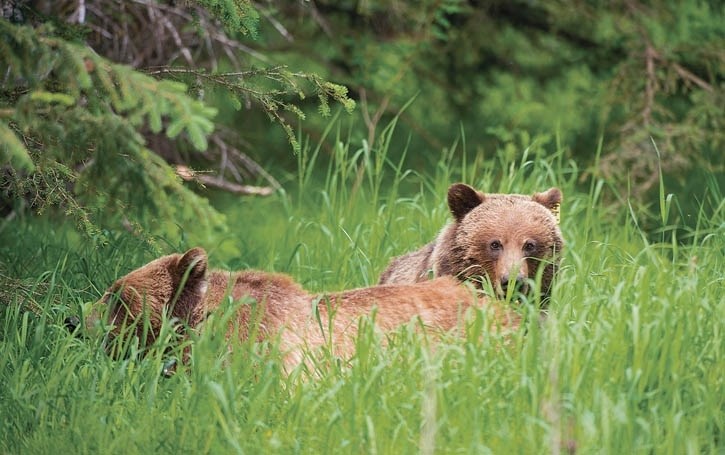One of Banff National Park’s former research grizzly bears has been euthanized after killing sheep and llamas near Sundre.
Bear 144, the four-and-a-half-year-old male offspring of bear 64, the famed former matriarch of the Bow Valley before her death in 2013, and bear 122, the dominant male in the area, killed 10 different animals in three separate livestock depredation events.
Provincial wildlife officials say there is a strict set of guidelines to determine a course of action, and because 144 was a sub-adult male living on the edge of an agricultural zone that killed several livestock, a decision was made to euthanize him.
“The decision to euthanize the bear was not taken lightly and not one of us got into this to do this. We don’t do this often at all,” said Jay Honeyman, human-wildlife conflict biologist with Alberta Environment and Parks.
“It was obviously a public safety issue when he’s killing livestock and presenting himself around people’s homes in the middle of the day. His lack of wariness was also a bit of a concern.”
Honeyman said 144, who was identified by his yellow ear tag, killed five sheep in mid-June. He then killed one llama and one sheep on July 20 and three more llamas the next day on July 21.
He said the bruin was captured and euthanized in the following days.
“None of these animals were consumed by the bear, so it was a concern,” said Honeyman.
On May 28, 2014, bear 144 was fitted with a GPS collar as part of the Parks Canada-Canadian Pacific Railway joint action plan to look at ways to prevent ongoing bear deaths on the train tracks through Banff and Yoho national parks.
His collar was remotely blown off by Parks Canada last November before den up time. Because he was a rapidly growing bear, wildlife officials didn’t want to put an extra burden on him over winter with a tight collar.
Despite an aggressive bear trapping campaign to try to collar him again this spring, bear 144 evaded capture, but his two female siblings, known as 160 and 148, are both fitted with GPS collars.
David Gummer, Parks Canada’s acting resource conservation manager for Banff National Park, said bear 144’s death was unfortunate, but Alberta Parks and Environment carefully evaluated all of the circumstances.
“We were very disappointed and it’s definitely an unfortunate outcome for that bear and for the bear population,” he said.
“We certainly support Alberta Environment and Parks in their efforts to manage and protect grizzly bears as threatened species. It’s never an easy decision to make, and it’s always a last resort to have to euthanize an animal like that.”
Gummer said Parks Canada did receive reports on sightings of the bear during his time in Banff.
“He was relatively wary and moved readily away from people when he had the chance,” he said.
Gummer said Parks Canada had one solid season of data from when 144 was collared, from May 28 to October 1, 2014.
In that time, he said, he travelled almost 400 kilometres over a 780 square kilometre area of habitat.
He said he ranged mostly in the middle Bow Valley, including Banff and the Sunshine area. He ventured into Kootenay National Park, Assiniboine Provincial Park and provincial lands near Canmore.
“He crossed a lot of different jurisdictions in that home range,” he said.
Bear 144 showed up in Canmore and Harvie Heights earlier this spring, but dropped off the radar after that, and because he was no longer fitted with his collar, wildlife officials lost track of his whereabouts.
“He wasn’t really doing anything here. He was feeding on people’s lawns, eating grass, but he wasn’t getting into any garbage,” said Honeyman.
“But he did have a certain level of habituation and indifference to people.”
Grizzly bears are considered a threatened species in Alberta, with estimates there are fewer than 700 grizzlies province-wide. The population numbers are currently in the midst of being updated.
Honeyman said there are more reports of bears dispersing east of places like Kananaskis Country, and to a lesser degree from Banff National Park.
“Young dispersing males are looking for places to go. A lot of places in the parks are already occupied and some bears are going east and finding out that some of these areas are unoccupied and potentially available,” he said.
“If it’s a bear that’s grown up in Banff and all of sudden moves out to Sundre, it’s a very different landscape, and it’s a bit of a struggle for a bear to try to find out how to make a living out there versus what they’ve been up to in Banff.”
In 2014, the number of reported human-caused grizzly bear mortalities was 19 in Alberta. That was down from 31 known grizzly bear deaths in 2013 and compares to 15 in 2012, 18 in 2011, 21 in both 2010 and 2009, 20 in 2008, nine in 2007 and 12 in 2006.




